458th Bombardment Group (H)
Pilot’s Memoir – 1Lt Curt M. Vogel
Page 1
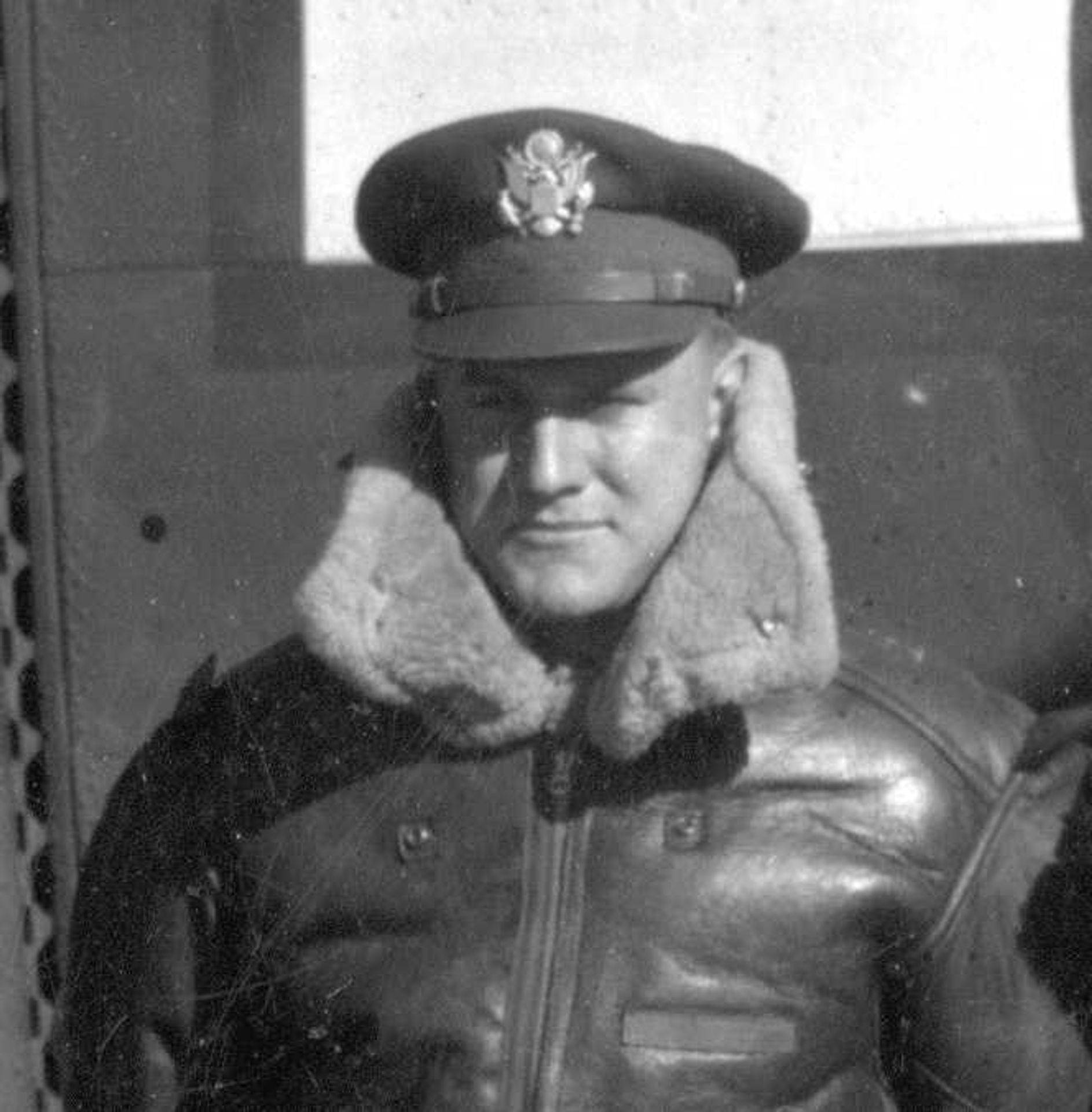
On December 7, 1941, Jean and I were at the matinee at the Mercier Theatre in Perryville, and as we left the theatre we were told the Japanese had bombed Pearl Harbor, Hawaii. We lived only a block from the theatre, and rushed home and the radio was giving constant coverage of what had happened. We knew, as millions of other did, that this meant war.
Jean and I were married in February 1941, and I had started law practice in August 1941, about three months before Pearl Harbor.
In January 1942, I enlisted in the Army Air Corp to become a pilot. To get into the Cadet program I had to pass a written test and had to lose 26 pounds in six weeks. I was 25 years 3 months old. (26 years was the maximum age for acceptance as a cadet).
I passed the written test because about 50% was on vocabulary, and the math was not too difficult, but the part about aviation was difficult because I had never flown in a plane, except for a 15-minute ride in a Ford tri-motor plane and had never touched the controls of an airplane. The weight loss was a bigger challenge but I got down from 211 pounds to 184 pounds in six weeks.
Also, I had to sign a statement that I would not claim an allowance for dependents as long as I was a cadet.
In April 1942 I was sworn in as a cadet, but because the pilot training program was crowded, I was not called into service until August 1942. On October 22, 1942, our son, Curt Milton II, was born. Technically, he should have been Curt Milton Jr., but we didn’t want him called Junior so we always called him “Buddy”. Jean and I and the family still call him Buddy, but everyone else calls him Curt or Dr. Vogel, since he is now a Vascular Surgeon. Simple mathematics will indicate that he was conceived in January 1942, the same month I enlisted as a cadet. Jean and I seriously discussed the implication of having a child with the impending war, but both of us decided we wanted a child although sheer logic and conservative common sense would have ruled against that decision. Personally I knew Jean could possibly be left alone with the child, but I also knew the child would be well cared for because Jean had a teaching degree and would give the child her complete love and affection. Our parents also would be there for her, even though when we told them that Jean was pregnant it was obvious they questioned the wisdom of our decision to have a child at that point in time. Buddy was born while I was in pre-flight training at Santa Anna, California. I tried to get leave to be in Odessa, Missouri, where he was born, but the army told me it was not an emergency, (I certainly thought it was!) because babies were being born routinely every day. Whether it was a boy or girl was not our concern, as long as the child was healthy, but I admit I was more than proud and pleased it was a boy, because at the time I was living in an open barracks with 30 other guys, so having a boy cut down on the normal good-natured kidding I was getting since I was complaining about not getting a leave and was obviously very nervous about the whole affair. Buddy was a healthy baby and he and Jean joined me during primary flight training in December, 1942, when Buddy was only six weeks old. Except for my overseas time, they were always with me at various stations from California to Langley Field, Norfolk, Virginia.
In May 1942, a month after I was sworn in as a cadet, I quit the law firm because I was to be ready to report somewhere with a few days of notice (7 days, I believe). Jean and I went to Odessa, Missouri, to wait for the call to come. As it turned out, the call did not come until August. Since it was the harvest season, I was fortunate enough to get a job at the farm of Earl Osborn, Jean’s uncle, near Odessa. My work consisted of helping harvest grain and hay, including getting wheat and oats to the threshing machine and also carrying the grain from the threshing machine to the grain storage bins. After threshing time, we gathered hay from the fields and stored it in the barn. I also chopped weeds and cockle burrs from the corn fields. Since the corn was at least five feet tall and much of it was in creek bottom fields, this was very hot work, and I remember sweating so much that I actually could pour out some water from my heavy work shoes. Doing this work was a real benefit for me, because it got me into very good physical shape, and although we had large and excellent meals, I didn’t gain any weight and had an excellent sun tan. My orders finally came in early August, 1942, to report to Kelly Field near San Antonio, Texas. Kelly Field was an old Army base but all we saw was a new area with new two-story army barracks which seemed a part of a Texas desert. There was no grass or anything green, just sand, dirt, gravel and rocks. We had a lot of drilling, at least four hours a day, a lot of calisthenics and a lot of running. We also picked up rocks and gravel and also scrubbed the barracks, inside and outside. In other words, they kept us busy from dawn to dusk. In addition to the above, we also ran the obstacle course almost daily, and as any GI can tell you, that is quite a challenge. Those two months on Uncle Earl’s farm in June and July turned out to be a real break for me because I was in excellent shape and was able to cope real well with the weather in August in Texas.
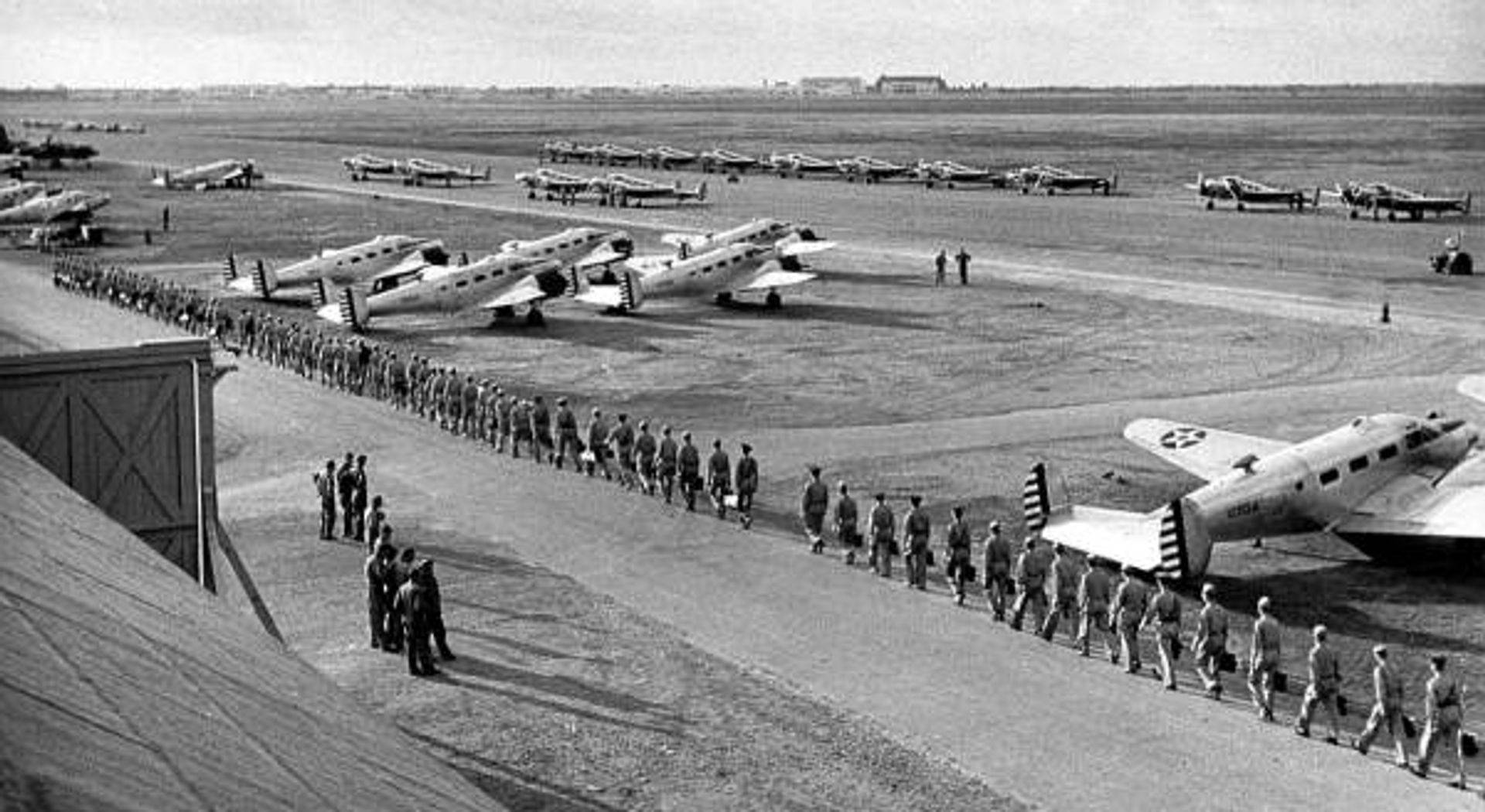
We had no classroom work except hearing drill sergeants yelling at us during drills (marching) and work details. We did learn to take orders, without questions, and we learned the difference between our left and right feet. Since I had taken ROTC (Reserve Officer Training Corp) in college, I had had some drilling and military training, but that was very mild, compared to this time at Kelly Field after about 3 weeks, we (about 40 cadets) were transferred to Santa Anna, California. This was a preflight school and had about 10,000 army personnel on the base. With our basic training at Kelly Field, we drilled in a strict military manner, which included marching to the mess hall, entering single file into the mess hall, standing at attention at the tables until we were told to sit down. We sat on the front six inches of the benches and did not speak except to ask to pass the food if it was not within easy reach. For the first two weeks at the weekly mass drill inspection, we won all the top awards, but after this time we reverted to the average discipline of the rest of the cadets. It showed me very clearly that in a very short time, human nature quickly reverts to doing the average unless discipline is continuously enforced. Our present “individual rights” philosophy makes it very difficult to demand respect for authority and without respect for authority, discipline is extremely difficult, which is obvious in our schools and society in general. A large segment of society believes that “individual rights” are more desirable and important than the rights of society as a whole, which is, in my opinion, a basic reason for many of the problems we have at this time.
After about two months of class room studies, I was transferred to primary flight training at Oxnard, California, just north of Los Angeles, California. This had been a private flying school and, based on the housing facilities, a very expensive one. It was called Mira Lorna. The sleeping facilities were in small cottages, with three cadets to a room (probably only two during peacetime) with toilet facilities. The original beds and mattresses were still there, and this was a far cry from army cots and mattresses. The food, however, was only fair to medium. The flight line facilities were excellent and the civilian flight instructor, a Mr. Simpson, about age 37, was also very good. We flew the Stearman trainer, which is a bi-wing plane and an excellent and sturdy plane and could do any kind of acrobatic maneuvers, including spins, snap rolls, slow rolls, etc. It was an open cockpit, two-seated plane, one seat behind the other. This type of plane is still used for crop dusting, because it can fly relatively slow (about 40 mph) and is very maneuverable. We were expected to solo before 12 hours of instruction. I didn’t solo until I had about 10-1/2 hours of instruction.
Many soloed with about 9 hours of instruction. From my first flight, I knew I loved to fly but with about four hours of instruction and while doing spins and stalls, my stomach became upset and I had to vomit. I was able to keep the mess to a minimum because I got to use a brown paper bag, which all of us had been issued, in case we got airsick. Besides the embarrassment, it also meant that if this happened again before I finished primary training, I would be “washed out” as a pilot and become a private in the army. Obviously this was the last thing I wanted to happen. So when I flew after that, I would not eat the previous two meals. If I flew in the morning I would not eat supper the day before nor eat breakfast, and if I flew in the afternoon I would not eat breakfast and lunch. In any event, I did not throw up again during primary and I successfully completed primary training.
Another matter came up during this time. One night one of my roommates, a fellow named Jack, missed bed check because he had gone into town. When the officer came by to check if everyone was in, I told him everything was o.k. But Jack was caught trying to get onto the base and I was called in to the Commander’s office because I had covered for Jack. I was given a very severe lecture and had to walk 10 hours of tours and this had to be done in a circle in front of the mess over a 3-day period. Also Jack “washed out” as a cadet two days later, supposedly because of his deficiency in flying ability, but his breaking curfew was, I believe, the real reason. I felt sorry for him but he came awfully close to getting me into real trouble. So covering for a friend’s mistakes may be a nice thing to do, but I assure you, it can also get you into a lot of trouble. Jean and Buddy came to Oxnard the early part of December 1942.This was a very rough train ride for Jean with a six weeks old baby. Needless to say, I was extremely happy to see Jean and get my first look at my son, Buddy, and to me both of them were absolutely wonderful and beautiful. We were extremely lucky that the Weitz family, whom I had met at the Lutheran Church at Oxnard, let us stay at their house and treated us as though we were a part of their family. We will always be grateful and thankful for their kindness. Our first Christmas as a family was celebrated with them. After finishing primary flight school, we went to Taft, California, for next level of flight training, basic training. The facilities for Jean and Buddy were far from adequate but Jean never complained.
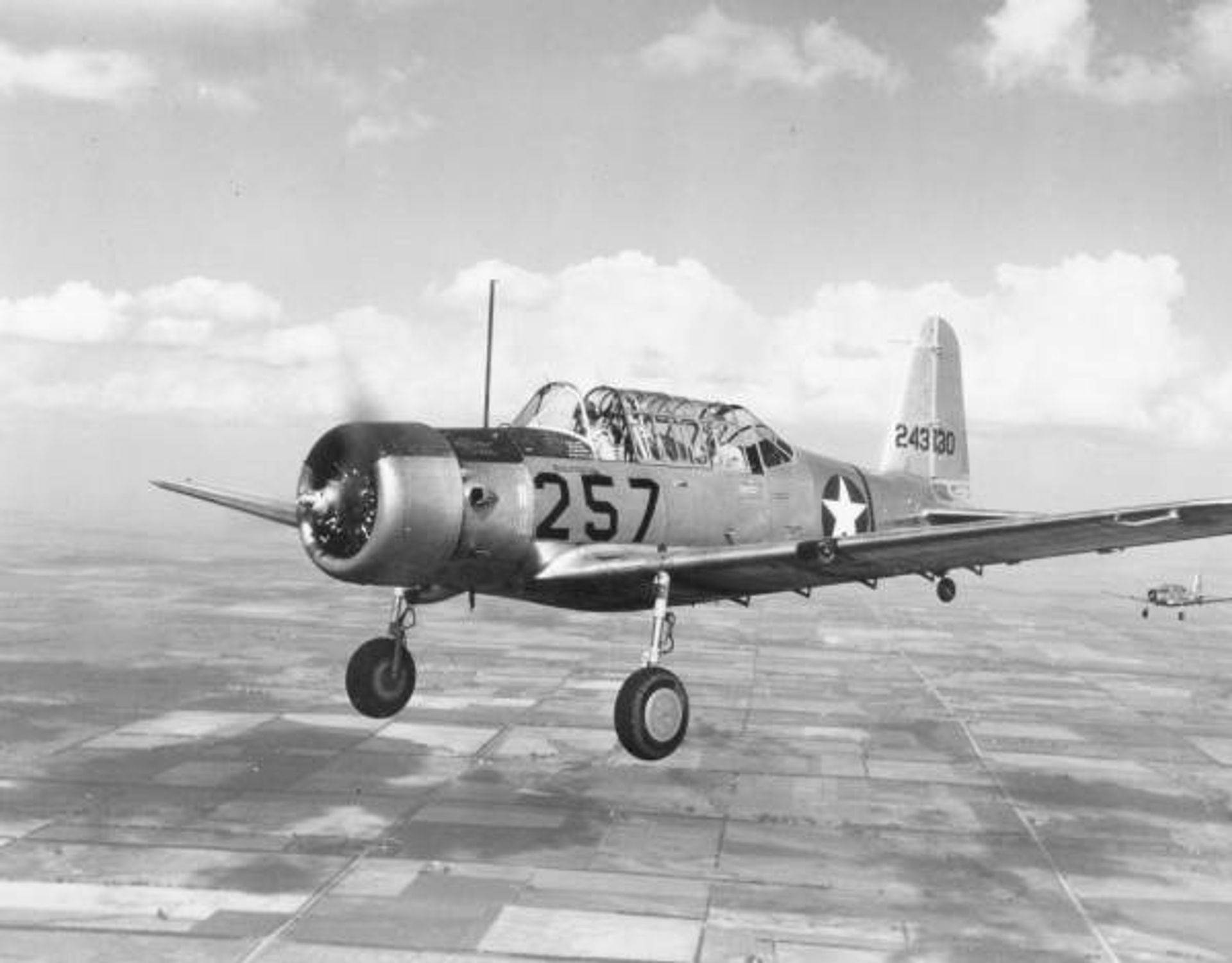
The plane we flew was a more powerful single engine trainer, a B-13 I believe. During our two months at Taft several things happened that I remember. Although I was only able to leave the base about one day a week, it was great to be with the family and I remember putting diapers on Buddy. Since they used safety pins and I was afraid of hurting Buddy, I developed a gentle but firm dexterity in my hands which I found was very helpful in flying the stick-shift airplane, particularly in flying on instruments, since it gave me a better feel on the controls. We also started night flying. One night while practicing landings with the instructor, the instructor told me to land and after landing he got out of the plane and said “Vogel, I think you are ready to do this on your own. Do you?” I of course said “Yes sir” and I then taxied out to the runway and took off and flew around for a few minutes and then made three or four touch and go landings. When I got out of that airplane that night, I really felt great, because I knew I could fly the airplane, not just by mechanically following instructions. I could make the airplane do what I wanted it to do. I never lost that feeling of being fully in control of any and all planes I flew later. Two cadets were killed in separate planes when they crashed while making their final approach for a landing. Whether it was pilot error or mechanical failure I never found out, but what happened later I do remember. Others of us were flying that same afternoon and after we landed we ate at the mess hall and went to the barracks. (I was in the same open barracks with about 30 guys). When we got there, all of the belongings of these two cadets were gone and the beds were realigned so that it appeared that these two cadets had never been there. This same procedure was also followed while flying combat. Also, the next morning at pre-flight briefing, we were told what might have happened to prevent it from happening again, and then the briefing officer said, “Your odds of living just went up because a certain percentage of cadets die during training.”
At the time I thought this a very cold blooded attitude, but it taught me an attitude about percentages, which I never forgot even in combat; namely 5%, 20% loss on a combat mission meant nothing but a statistic, but if the crew and I got killed that was a 100% loss. It also brought home to me the fact that there is a lot of truth in the old saying “Flying is not unsafe, but like the sea, it is terribly unforgiving of carelessness or neglect”. It was also at basic training that I threw up while flying. While soloing I was doing some training maneuvers and suddenly I became sick at my stomach. I did have time to open the canopy on the plane and I banked the plane and tried to get everything outside the plane, which I was successful in doing, but left a mess on the side of the plane and tail section. After things straightened out, I realized from the taste in my mouth that I had eaten a piece of lemon pie at lunch, which obviously was a big mistake. I made it a point to be the last one to land, and after shutting down the engine, I asked a corporal on the ramp to help me find a bucket of water and a rag. It was an unwritten law that a cadet cleaned up his own mess and did not ask an enlisted man to do it. This corporal, however, thought it was funny and helped me clean up the mess. I “suggested” he not say anything about this and then we went and had a couple of beers together. This was the second and last time I had an “upset stomach” while flying.
For Advanced Training we went to Stockton, California. There we found a motel room with cooking facilities and a very friendly owner and operator of the motel. The problem was the rent was $75.00 a month and my cadet pay was $75.00 a month. Again my parents, with the cooperation of my brother-in-law George Fischer, showed their cooperation by loaning us the necessary money to get through the two months at Stockton.
Advanced Training was in a two-engine plane built on a light frame and covered by canvas. It was an excellent training plane and very stable and easy to fly, particularly in formation flying. Another trainer, built like a smaller version of the twin engine B-26, was used also, but was too critical to handle because there was only about 20 miles per hour between cruising speed and stalling speed, which made formation flying dangerous, because when the plane stalled it would fall off very abruptly, and it would be hard to recover control. Everything went very smoothly during advanced training, including graduating and receiving my silver pilots wings and my commission as a 2nd Lieutenant in the U.S. Army Air Corps. This was a very rewarding happy and proud moment in the Vogel family.
One experience did occur while flying a routine night mission out of Stockton with another cadet (whose name I cannot remember). We took off while still daylight and we slowly climbed to about 8000 feet and headed north up the San Joaquin Valley. Stockton is in the Valley and about 70 miles south of Sacramento, California. On the West are the Coastal Mountains between the Valley and the Pacific Ocean, and on the East are the Sierra Nevada Mountains. As we were flying north we could see the sun getting close to the ocean horizon. It was a beautiful clear night and little or no haze over the ocean. As the sun became lower, but clearly visible to us at 8000 feet, the Valley below us became darker and darker, and for the first time in my life I realized that the phrase “night falls” is not accurate, and that night does not fall but that darkness starts at ground level especially in a valley with mountains or high hills to the west. As the Valley became completely dark, we began to see some lights from street lights and houses on the ground. At this point we were north of Sacramento and to the northwest we saw Mount Shasta in northern California, and its peak was completely covered with snow and ice with the clear sun shining on the mountain, it looked like a pyramid completely covered with sparkling white diamonds. The sun began to set and it was one of those perfect Pacific Ocean sunsets with its wide range of colors from light yellows to orange and finishing with a deep red. As the sun was setting, the snow and ice, which looked like a huge pile of diamonds, slowly changed from a bright white to the various colors of a beautiful Pacific sunset. As the colors were changing and the sun was setting, it appeared the mountain peak was slowly sinking into a soft sea of black velvet until it completely disappeared. I have seen quite a few sunsets over the ocean since then, but that one with Mt. Shasta will always be to me one of nature’s great masterpieces.
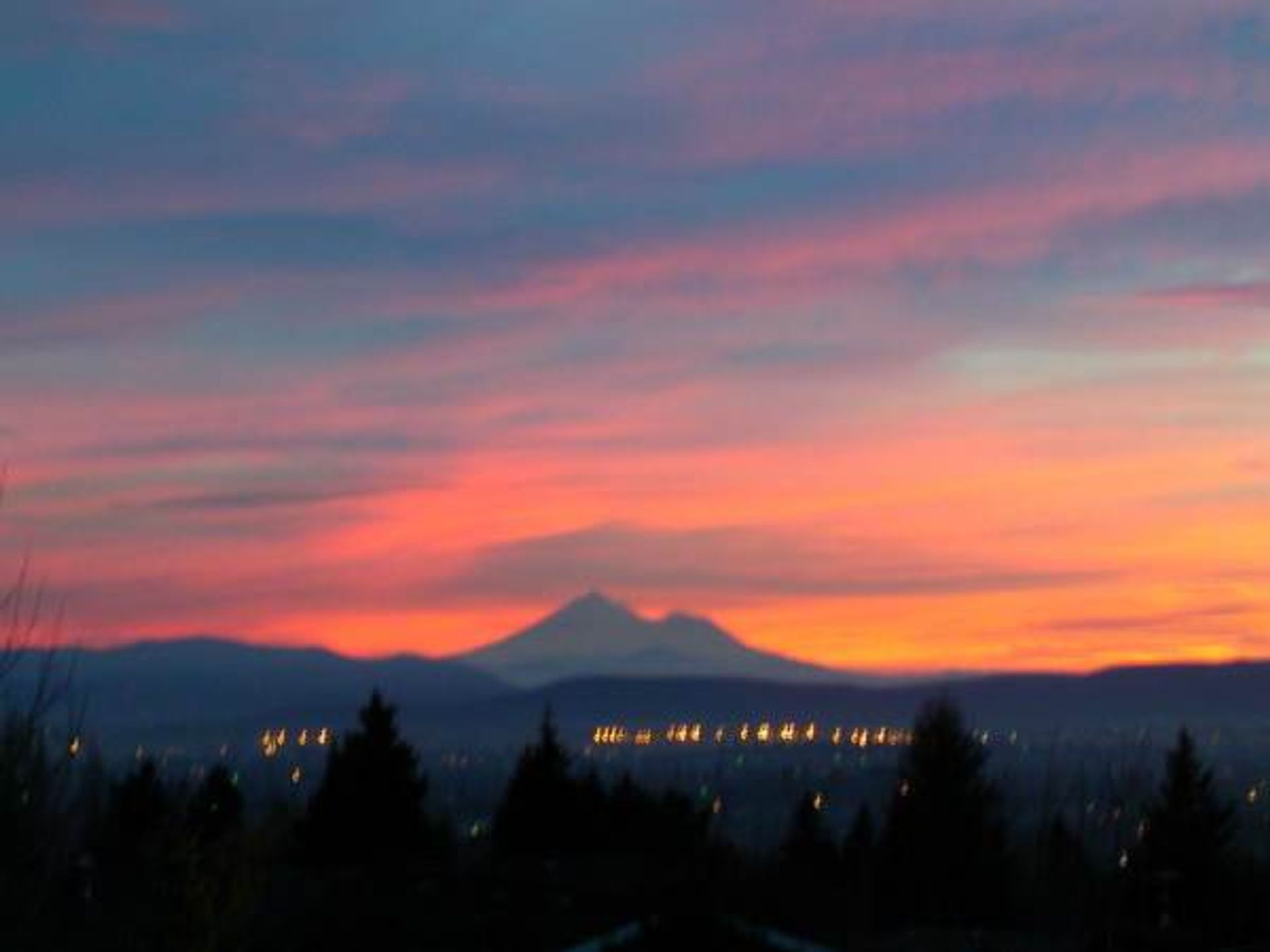
Being a commissioned officer, I finally made enough money to support my family, because I got the regular 2nd Lieutenant’s pay, plus 50% flight pay and regular dependent’s pay. As previously stated, I had to waive dependent’s pay while I was a cadet. We were then transferred to Mather Field near Sacramento. Here we rented a very nice house with Nelson and Peggy Stewart. Nelson was also a pilot and was and still is a good friend. We were trained in two-engine B-25 Mitchell bombers. The B-25 was an excellent plane and a pleasure to fly. When we told my parents we would probably be sent to the South Pacific, they decided to visit us, which they did after a very long train ride. The day before they got there we received orders that we were being transferred to Hobbs, New Mexico, for training in the B-17 4-engine bomber known as the Flying Fortress. We had three or four days with my parents. The troop train we were on and their train left Sacramento within a few minutes of each other. Before we got to Needles, California, some train ahead of us had blocked the tracks and both our trains stopped in this very hot desert area, but it gave us another couple of hours to visit with my parents. We even have a picture of mother and Buddy sitting on the hot railroad tracks on a very hot July day. My parents then went on to Los Angeles to visit some friends. We only stayed at Hobbs, New Mexico, about 3 weeks but did a lot of flying and studying the B-17, which was an easy plane to fly and very good for formation flying.
Just as we were getting the feel of flying the B-17 we were ordered to Gowen Field in Boise, Idaho, by way of Wendover, Utah, to train for combat in the B-24 Liberator 4-engine bombers. Before we left Hobbs, New Mexico, our ground school instructor, a Captain, flew a B-17 to Dayton, Ohio, to Wright Patterson Field, and brought back over 100 B-24 Manuals on the operation and maintenance of B-24s, which he gave to each pilot to study and use. How he could have talked some supply officer into giving B-24 manuals at a B-17 school I do not know, but he did, and in so doing did the other pilots and me a tremendous favor, for which I will always be very grateful. As we left Hobbs, New Mexico, we got a leave plus travel time which added up to about 20 days. We visited my parents in Altenburg and Jean’s parents at Odessa, and then with Nelson and Peggy Stewart, the five of us left for Boise, Idaho. We had bought a used car during this leave time (which turned out to be a good car) and had a nice trip through the Midwest including Yellowstone Park and other scenic areas between Odessa and Boise, Idaho. Boise was a very clean and nice city and Jean and Buddy found a satisfactory room and so did Peggy Nelson. We also found out that the slogan “Beautiful Purple Hills of Idaho” was a fact and not just a slogan to lure tourists and potential residents to Idaho.
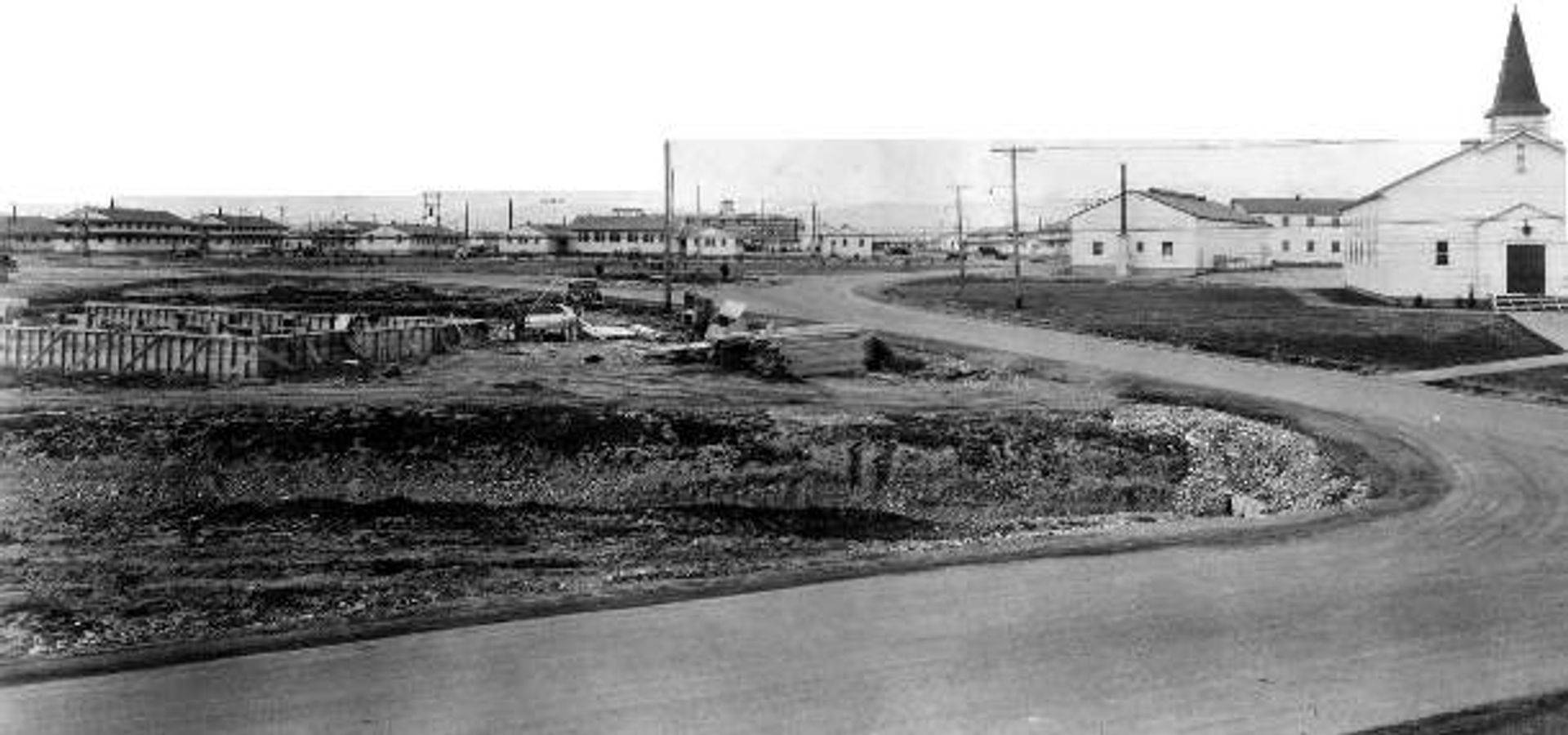
When we got to Gowen Field, it became very obvious to all of us that we were being trained to become a Bombardment Combat Group. Also, until we finished our combat training, our schedule was 12 hours on the flight line and 12 hours off. The 12 hours off was the time for two meals, doing any chores required, studying, cleaning up and sleeping. The only time we had 24 hours off in succession was when we switched shifts which was every seven to ten days. This was also the only time we could see the family. The 12 hours “off” the line didn’t leave time to relax (except sleep) and not time to read or listen to the radio. On one of these 24 hour breaks, Jean, Buddy and I went to the City Park and while looking at the juke box at the concession stand I noticed that two records had the song called “Pistol Packing Mama”. To find out what the song was, I put a dime in the machine and after hearing it, I said “that is a really dumb song”. The 16-year old boy behind the counter looked at me as though I was the dumbest guy he had ever seen, and he said to me “Mister, that has only been No.1 on the Hit Parade for the last two weeks.” The Hit Parade was a weekly national radio show that played the top ten most popular songs. I obviously had not listened to the radio for several weeks, and although I heard that song many times after that, my opinion of it did not change.
The B-24 Liberator bomber has the following specifications: Wing span 110 feet; length 66 ft. 4 inches; height 18 ft. 11 inches; Gross weight 56,000 lbs.; 8000- lb. bombs; 4 Pratt Whitney engines, 1200 h.p. each; Cost about $250,000. It has a tricycle landing gear which I liked, and I thought it looked pretty good, but to others it was called a “flying box car” and it does not have the smooth lines of the B-17 and some other planes. However, from the first time I flew it I liked it and I studied hard to find out exactly what it could do and where it was different from the B-17. When the B-17 and B-24 were discussed and compared, somebody would always say “Most pilots say the B-17 was a better plane than the B-24” and I would say I didn’t think so, but it probably took better pilots to fly them. This was not true but they usually then changed the subject.
At Gowen Field a lot of things quickly fell into place to make us a 10-man combat crew. First a co-pilot, Al Hilborn, was assigned. Then a bombardier, A.J. Testa; flight engineer Joe Brown; radio operator Bernie Doyle; Waist gunners Don Murphy and Al Walczak; belly gunner Ray Potts; and tail gunner Chester Carlstrum were assigned to the crew. The navigator Sam Scorza was the last to be assigned to the crew, either at the end of training at Gowen, or as we got to Tonopah, Nevada. I had no part in choosing these men and they also had no choice in choosing to be on the crew. Since I was 27 years old and had a very German name, I was told by Joe Brown and Bernie Doyle (many years later) that the reaction of the younger guys (about 9 years younger) was less than enthusiastic to have an “old man” and a guy with a very German name as pilot. Regardless of their initial reaction, we very quickly became a good smooth operating crew with everybody doing their assigned jobs in a very efficient and cooperative manner. The full names of the crew members were: 2nd Lt. Curt M. Vogel, Allen C. Hilborn, Samuel D. Scorza and Alex J. Testa, and S/Sgt. Joseph R. Brown, Bernard J. Doyle, Albert W. Walczak, and Sgt. Chester Carlstrum, Donald P. Murphy and Ray J. Potts, when we left Tonopah for overseas. Murphy was replaced before we flew any missions because of a bad attitude. When I told him he was to be dropped from the crew, he indicated he had no objection and in fact he seemed relieved. He never joined another combat crew. Murphy was replaced by a Sgt. Goldstein, but on about the third mission while flying with another crew, he was killed. He was replaced by Sgt. Lovell West.
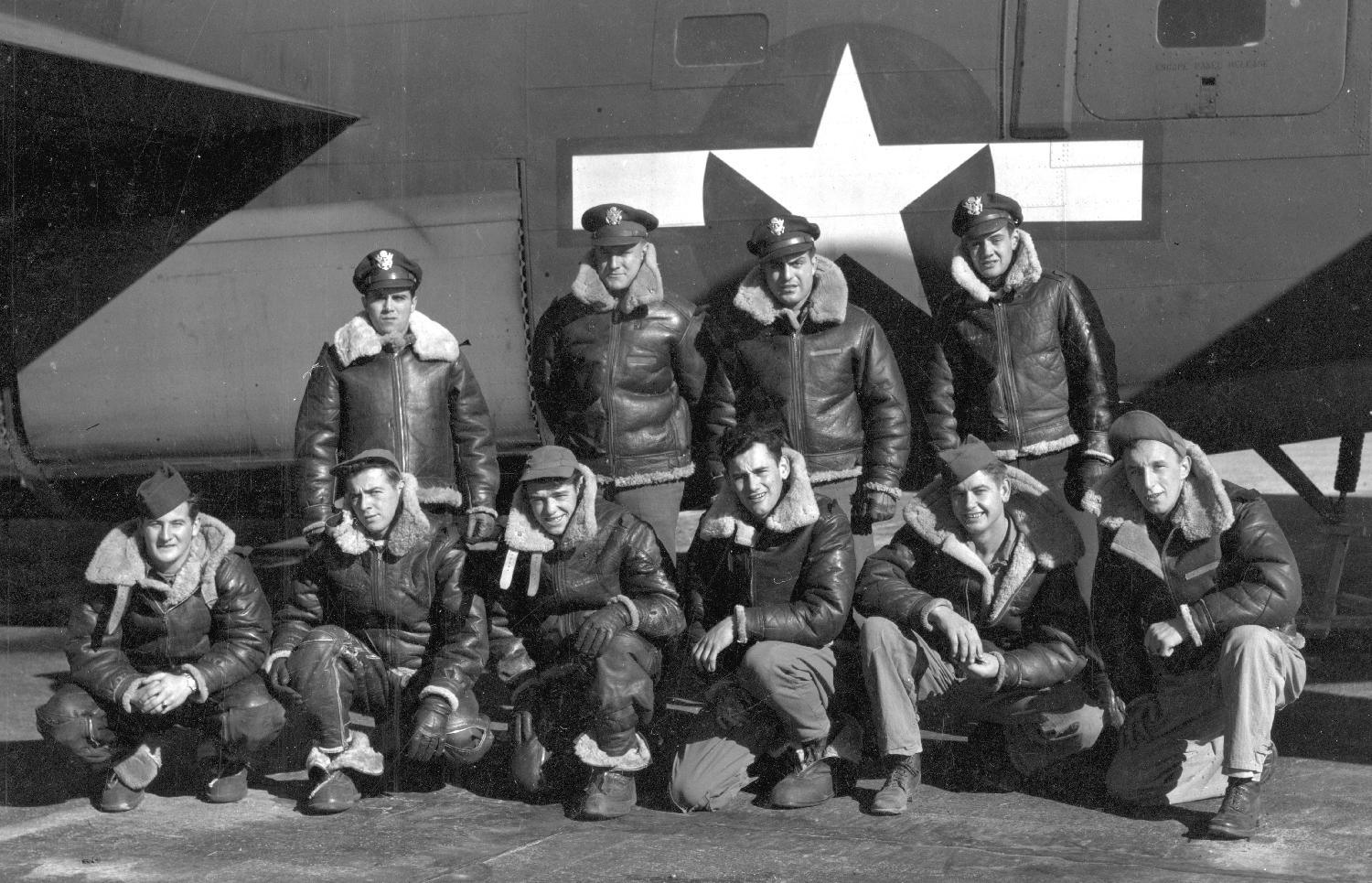
About October 19, 1943, we were transferred to Tonopah, Nevada, which was located in a very isolated and mountainous area, about 200 miles south of Reno and about 200 miles west of Las Vegas. Jere Hilborn, wife of Al Hilborn, the co-pilot, joined us there. The air base was being greatly expanded to accommodate the 458th Bomb Group, which we were. When we got to the town of Tonopah, there was no housing available, especially with a baby, so we persuaded a housing officer to sleep in a newly constructed barracks, which just had base cots and blankets. Jean always wondered what some soldiers thought when they found some baby socks in the G.I. barracks. The next night we stayed in Goldfield, Nevada. Goldfield is a mining ghost town in desert country about 20 miles south of Tonopah. It was the site of a gold rush which began in 1902 and ended in 1918. In 1910 production of ore was valued at more than 11 million dollars. Peak population from 40,000 in 1910, to less than 200 in 1943. The 200 room Goldfield Hotel was closed for many years but was opened a day or two before we got there. This is a 4-story brick building. When we walked into the lobby, we saw what was once a very elegant lobby but dust all over the place. They said they had a room so we took it. It was on the second floor and as we went up the carpeted steps dust was flying with every step we took, and looking to the next floor, all we saw was dust and cobwebs covering the stairs. It was obvious someone cleaned up to the second story only. By saying “cleaned up” I am being very charitable. Our room was just short of filthy. Needless to say, we only stayed one night. Later it was cleaned up a little more. Jere, Jean and Buddy found a small house to rent, largely through the efforts of Jere, who convinced he bartender at the only bar in town that they were desperate for a place to stay, especially with Buddy.
Combat training began in earnest. We did a great deal of formation flying, as well as bombing and navigational flights. At our squadron, the 755th, everything went very smoothly, and all the pilots and crews got along very well and were always cooperative. Lt. Col. Robert F. Hardy was the commanding officer but when the 458th Bomb Group was inspected by the higher brass, evidently everything was not up to expectations and Lt. Col. Hardy was relieved of command. This was about 2 weeks before the Group was to go overseas for our combat assignment. Col. James H. Isbell was appointed Dec. 16, 1943, to take command and he was a fine officer and everything seemed to flow smoothly after that, and he was highly respected as a combat Group Commander by all of us. Largely due to Major Jamison, who was our Squadron operation officer, our squadron was not part of the problem. His leadership and friendship at Tonopah and during our combat tour made our squadron a close-knit and cooperative organization.
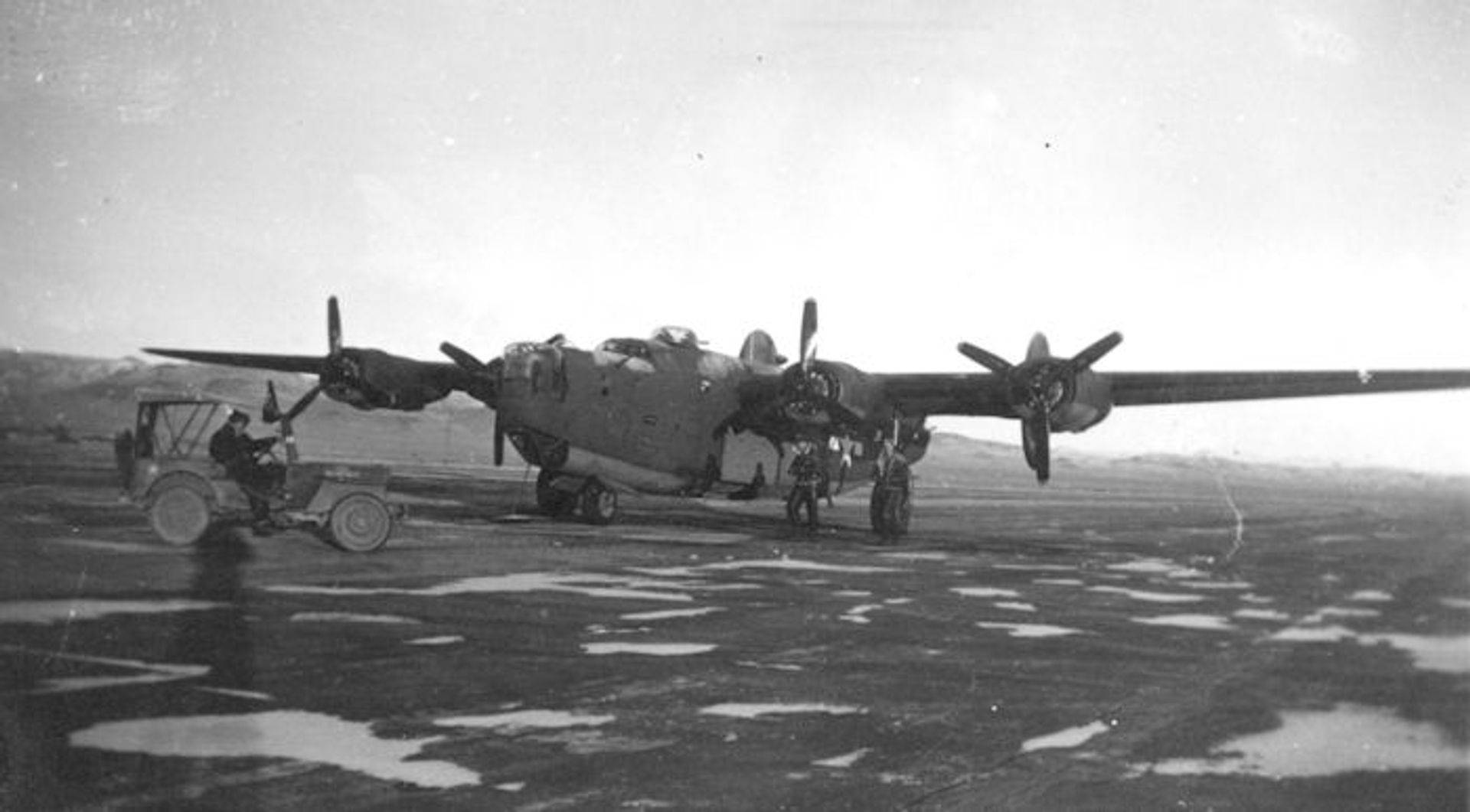
Our crew received a brand new B-24 about Dec. 24, which was our plane, and which we were to fly overseas and in combat. We flew the plane every day to get the feel of it. I liked the plane very much and we found no major problems after putting it through a very varied series of tests.
We knew the Group was to leave Tonopah Jan. 1, 1944, and we were to fly to Hamilton Field, California, about 60 miles north of San Francisco and near San Raphael, California. Jean, Buddy and Jere left January 1 to meet us at San Raphael even though we knew we might only be there a day or two before leaving for overseas. This trip by car was over the mountains at Donner Pass and Lake Tahoe. When they neared the mountains at Reno, Nevada, it became obvious that there was a severe snow storm over the mountains.
They asked a station attendant if they needed chains and he told them he thought they could make it without chains. The snow got increasingly worse and the road was treacherous, but miraculously, or was it the protection of angels, they were able to cross this mountain and make it to Sacramento that night.
On January 1 we were scheduled to fly an 8-hour fuel consumption check on the plane and leave the next morning very early for Hamilton Field. All our packing was to be completed on January 1. The fuel check consisted of checking the fuel consumption on various power settings on the engines and at various pitches on the propellers. We flew south to around Los Angeles, and we could see the Coliseum where they were playing the Rose Bowl football game. The flight was on a nice clear day and all the tests were made, and all checked out within normal limits. However, when we got back over Tonopah we were informed there was a change of plans. We were old not to land at Tonopah but to proceed immediately to Hamilton Field. We were told our luggage would be flown there in the morning. Al Hilborn’s luggage and mine were already on its way with Jean, Buddy and Jere in the car. We were also told weather was no problem except that Hamilton Field had a ceiling of a 1000 feet and that it would be much less after midnight and we might not be able to get in there tomorrow morning because of the fog. The navigator, Sam Scorza, gave us a heading for Reno, since I wanted to cross the mountains at Donner Pass, which I knew could be crossed at less than 12,000 feet.
The weather report proved to be very inaccurate and when we were about 100 miles out of Reno we ran into heavy rain and an electrical storm which made our radios practically worthless because of the static. Our radio compass could not pick up Reno, and even Bernie Doyle, the radio operator, could not get through to Reno to get the weather report because of the static caused by the electrical storm. When the navigator estimated we were about 60 miles south of Reno, I decided to try to go across the Sierra Nevada Mountains in the area of Lake Tahoe. We had no oxygen (we were to get it at Hamilton Field) so I decided to go to 12,000 feet. As we passed the foothills of the mountain we ran into extreme turbulence and a blizzard. We were, of course, completely on instruments and I noticed after a short time that we were losing altitude, even though the plane was flying level, and hen the air speed started to drop, even though we were at full cruising power. I immediately lowered the nose of the plane to gain speed, which had gone down to 145 mph from a cruising speed of 165 mph. I also made a 180 degree turn to the right away from the mountains and after a short time we broke out of the blizzard conditions into a relatively clear condition except for heavy rain.
To our pleasant surprise we came out about 20 miles south of Reno. What must have happened, weather wise, was that as we tried to cross the mountains, we hit the snow storm coming over the mountain, which created a terrific down-draft coming down the mountain and was also moving north at a high speed. This would account for the rapid loss of altitude and also the loss of indicated air speed. After we saw Reno, I knew exactly where to cross the mountains, since I had flown this route several times while flying B-25s out of Mather Field at Sacramento. Sam gave me the new heading across Donner Pass and then a heading for Sacramento because I wanted to check the weather to Hamilton Field because the weather given us at Tonopah was not even close to being what we had encountered. As we neared Sacramento and Mather Field, Al Hilborn contacted the control tower and asked for the weather report at Hamilton Field. The weather report was that the ceiling was now at 500 feet and expected to drop at Hamilton. 500 feet was the minimum ceiling for an instrument landing, at that time, and since the weather was getting worse and I had not flown into Hamilton before and we were getting low on gas, having flown over 9 hours, I requested permission to cancel the flight plan to Hamilton and permission to land at Mather Field. Permission was granted to land at Mather.
After landing in heavy rain and after dark, I told the crew they could go into town but be on the flight line at 7 A.M. probably none of them had been off the base at Tonopah for two months because the town of Tonopah had little of anything for them to do. As far as I know, they had all gone into town except Bernie Doyle, the radio operator. He told me much later that he didn’t go because he felt he had let the crew down by not being in top condition because of excessive drinking New Years Eve, the day before. I assured him the unusually bad weather conditions caused the problem with the radios and his physical condition had nothing to do with his failure to get radio reports near Reno. This is an example of true dedication of a crew member, and he and the other crew members (except Murphy) in their own way demonstrated their dedication to always work as a team and to do nothing to let the crew down. This dedication of the crew, including Lovell West, who took Murphy’s place, was and is one of the most satisfying and rewarding experiences in my life, and I will always be extremely grateful to each and every one of them. Al and I told the crew we would go into Sacramento and eat and have a drink at one of the best hotels in town, the Senator Hotel, and they could join us if they wanted to. As we walked into the hotel lobby there were Jean and Buddy and Jere, Buddy wearing a red suit (14 months old) looking up at a large Christmas tree and Santa Claus poster. Jean and I couldn’t believe how this meeting could possibly happen. Although we knew Jean and Jere were on the way to Hamilton Field, we had not the slightest idea where they might stop. Also, we were scheduled to stay in Tonopah until the next day and then fly to Hamilton. Us meeting in Sacramento was 100% coincidental, but to this day some crew members, especially Doyle and Brown, insist it was all pre-arranged, which of course it was not. After relating the story again, I must admit I have trouble believing it even though it actually happened just as I described it.
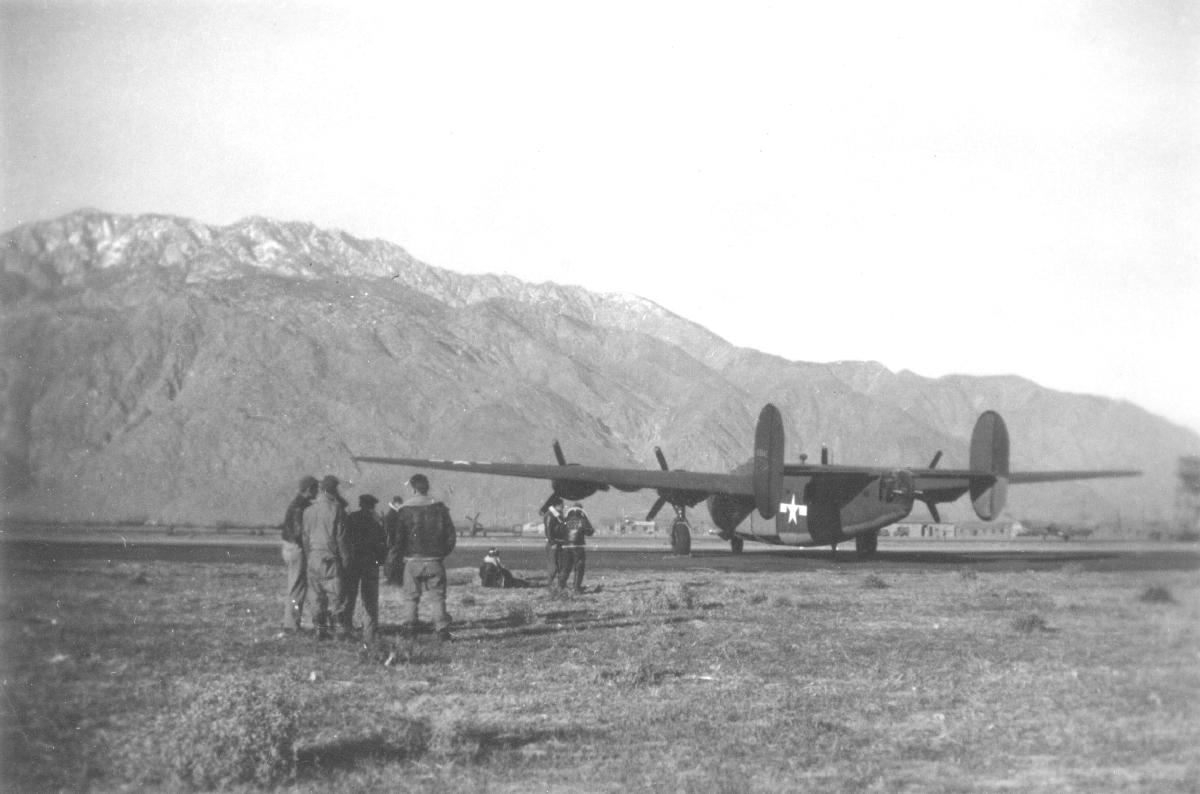
[On January 10, 1944, the crew flew from Hamilton Field to an ATC Field in Palm Springs,CA, leaving there the next morning.] Our first stop was at Midland, Texas, then Memphis, Tennessee, and then Morrison Field, near West Palm Beach, Florida. All this time we were flying in a loose formation of 6 planes, which changed at Morrison Field when we were strictly on our own. We were handed an envelope just prior to take off, marked “Secret Orders” and we were not to open it until one hour after taking off on our way south to Waller Field, Trinidad. We took off about 3 A.M. January 20, 1944. I remember the tower operator giving us a clearance to take off and reminding us to make an instrument take-off. The reason given for the instrument take-off even though it was a perfectly clear night was that since we were taking off to the west over sparsely populated ground, the ground with only a few widely separated lights on the ground looked exactly like the stars in the sky, and there had been fatal crashes when the pilot became confused which was the sky and the stars and the ground with the isolated lights. After we were up about 2000 feet, I glanced out at the sky and ground and knew how much each view looked about the same. As we left the control area of the airport, I reported our position, and the control operator cleared us and said very sincerely “Have a good flight”. I could not tell if he was just being nice or whether he wished he was going with us. When we were out one hour we opened the secret envelope and the orders were: “Eighth Air Force, England”.
It could have been China-Burma, Africa, Italy or the 8th Air Force in England. Since I announced this on the intercom, I do not know how each crew member reacted but each of them knew the 8th Air Force was suffering very heavy losses in the air over Europe since the papers and radios carried this information daily. They all took it in stride and I never heard any complaints, and as good military men, they knew you take and obey orders and do not question them.
The engineer, Joe Brown, shortly after we took off, informed me that there was gas flowing into the bomb bay section of the plane, and it looked like it was coming out of the right wing. All gasoline tanks are in the wings. The regular tanks hold (as best I remember) 2200 gallons and there are wing tip tanks which hold about 200 gallons each. I told him to check the leaks and to open the bomb bay doors a few inches to let the fumes escape. After about 10 or 15 minutes the leaks stopped. We did not know what caused the problem, but we wrote it up on the plane’s log after we landed at Waller Field, Trinidad, South America, after a flight of about 11 hours. The weather was beautiful and we had an excellent view of several islands in the Caribbean, with beautiful beaches and the various colors of the waters around the islands.
January 22, 1944, we flew to Belem, Brazil. Belem lies just south of the mouth of the Amazon River. In flying over the Amazon at about 1500 feet we saw a very large number of animals on the ground and fully realized that the mouth of the Amazon is over 100 miles wide just as we were told in Geography class in grade school. The flight to Belem was about 7 hours and as we were over the Amazon River, we also crossed the Equator. The gas leak again showed up on this trip and was told they should be able to fix the problem at Fortaleza, or Natal, Brazil. At Fortaleza we were told it could be fixed at Natal. The mechanics checked out the problem but could not find any leak so I told them to fill all the gas tanks including the wing tanks, and if that gas was not leaking into the bomb bay when we got to 500 feet after takeoff, I would forget about the problem. Two mechanics went on the test flight and by the time we got 300 feet off the ground gas was pouring into the bomb bay. I heard one of the mechanics say very loudly, “Get this damn thing on the ground!” They then proceeded to replace the right wing tip tank and checked the other tanks. This job took over five days and turned out to be a real relaxing time for the crew because the weather was beautiful at that time. Although all that work was done, the problem of the gas leak was not solved and every time we needed the wing tips full we had this gas problem, but we would crack open the bomb bay doors and turn off the electrical circuits in bomb bay area. Although this was a potentially dangerous condition, nothing bad ever happened, which is obvious, because I am able to write about it now.
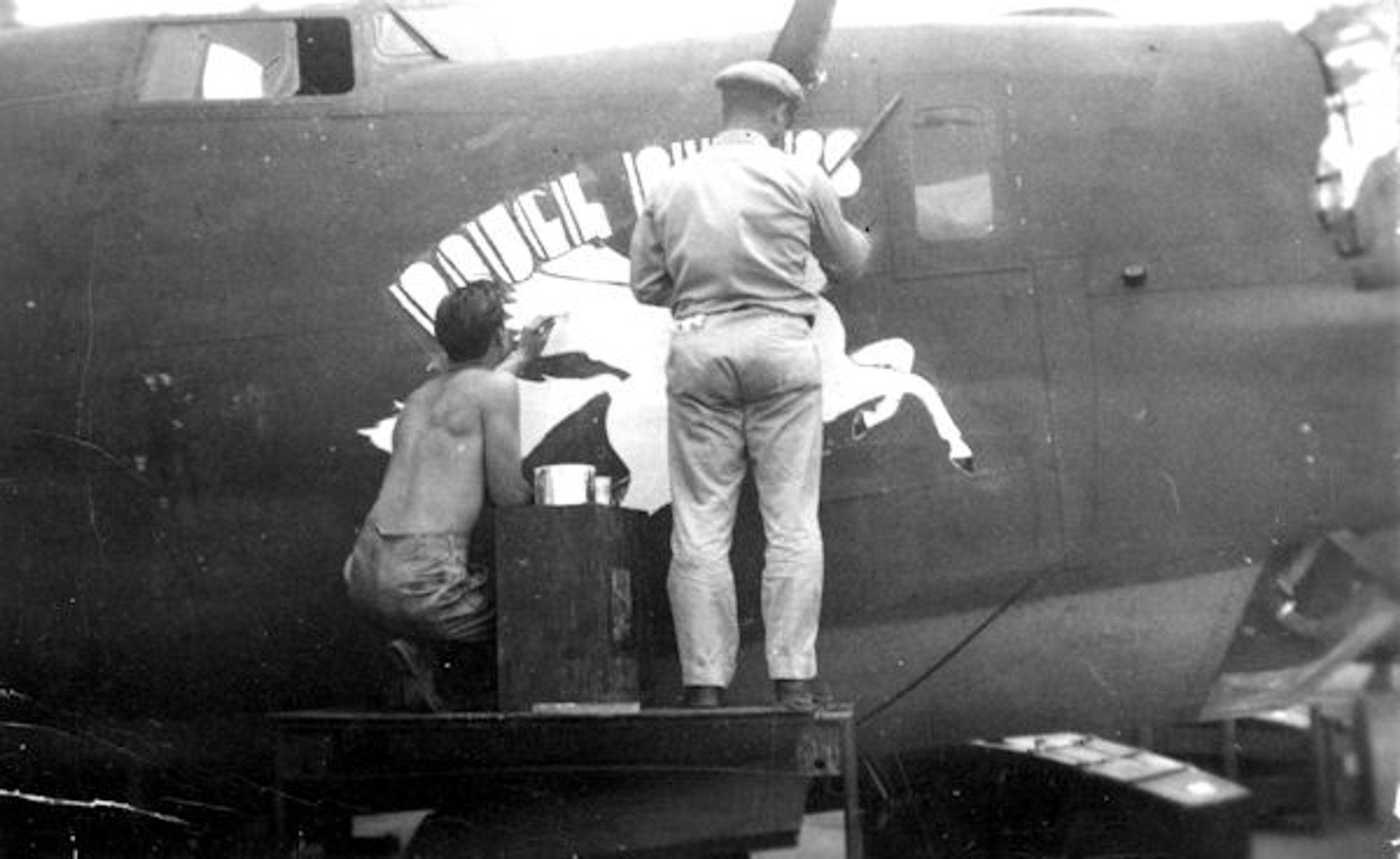
During this time at Natal when they were working on the gas tanks, Joe Brown, who had taken course in commercial art and A.J. Testa, who also had artistic ability, with other crew members (not me) painted our name and logo on the nose part of the plane. The name was Rough Riders and logo was a white horse with wings. The horse was Pegasus from Greek Mythology, who was a great war horse and was taken into the sky by Zeus, the Greek God, and is now a constellation in the sky. Joe thought it should not be all white so he made the mane and tail and hoofs red. Rough Riders was the name for a famous American Regiment which fought under Theodore Roosevelt’s leadership in the Spanish-American war in 1898 in Cuba. The logo and name were arrived at after a lot of discussion by the crew. After they finished painting it, I liked it very much (and still do). Some of the crew members probably would have liked something more current. I later found out that some crew members were discouraged from making any suggestions because I had emphatically stated “No nude or semi-nude girls”. Some other drawings were made near the waist guns and near the tail of the ship, [and above the ball turret]. Also on the radio compass, a homing device on the top of the plane, they painted “Jean” on one side and “Buddy” on the other. On the pilot’s side they painted “Boss” and on the Co-pilot’s side they painted “Quiet -man sleeping“. However, both “Boss” and “Quiet -man sleeping” were covered up when armor plate was put over this part of the plane. This armor plate was about 30 inches square on both the pilot and co-pilot side directly under the window. The armor plate was about 1/2 inch thick and was put on after we got to England, as well as bullet proof glass over one inch thick all around the flight deck.
While writing this and realizing that most of the crew were about 19 years old at the time and girls were a very large part of their thinking mechanism, I am reminded of a comic strip in reference to recruiting and girls. The story went something like this –Young recruits were being examined by a psychiatrist and since it was getting late in the day, the doctor asked how many more he had to examine. The nurse told him only three more. So the doctor said to bring them all in at the same time. He then told them he would blindfold them and then on his command they were to remove the blindfold and that he would be doing something at the time he gave the command, and they were to tell him what that reminded them of. The doctor took out a white handkerchief and was waving it when he ordered the boys to remove their blindfolds. The first boy said “This reminds me of sailing ships” and when asked why, he said he was from Maine and lived near the coast and would see white sails on the ships out at sea. The doctor said that this reminded the boy of home so he told him he could go. The second boy said it reminded him of clothes on the line. The boy explained he lived in a tenement district and that clothes lines were extended between the tenements to dry clothes. The doctor said that he was thinking about home, which was fine, and told him he could leave. Then he turned to the third boy and asked him what waving the handkerchief reminded him of. This boy said “Girls”. This surprised the doctor very much and he told the nurse to leave the room. The doctor, obviously surprised at the answer, started to explain to the boy that he was puzzled at the boy’s answer, but before the doctor could finish, the boy interrupted him and said “Doc, don’t get excited about this. It wouldn’t have made any difference what you did because I always and at all times think about girls”.
I’m not implying that some of our crew members always thought about girls but if any of them would have preferred a “girl” as a logo instead of a flying horse, they basically got their wish since the last mission, the 30th, we flew in a plane with the name Princess Pat and the picture of a very beautiful girl in respectfully minimum clothing, and the picture taken after we landed after the 30th mission has this name and logo in the background. The reason we were not flying Rough Riders on our last mission will be explained later.
After the repairs on the plane, we left Panarim Field, Natal, Brazil, for the flight across the Atlantic Ocean on February 3, 1944, for Eknes Field, Dakar, French West Africa. This trip over the ocean was about 10-1/2 hours. Dakar was a French Colony. It was garrisoned by native troops; the Senegalese. They carried long bayoneted rifles, wore red fez caps, blue pants and khaki shirts. On landing we were told to take our necessities because after dark no one went to the plane and anyone who tried would be shot, because these soldiers did not speak English and would not ask questions, but would shoot as they were ordered to do. We slept on canvas cots surrounded by mosquito netting. The barracks were sprayed by native men with long spray guns — something we were not told they would do. In any event, just as I was going to sleep four men appeared at the end of the barracks. They said nothing but with these long spray guns they looked like four guys with sub-machine guns. Remember it was getting dark, we were behind mosquito netting on our cots, and we had been told the natives were told to shoot. After a very short time these four men came down the aisle and in perfect step started spraying for mosquitoes with their spray guns to both sides of the barracks. Right after they left almost everybody started laughing at this odd method of spraying for mosquitoes, and we were all relieved that was what they were doing.
On February 4 we flew to Marrakech, French Morocco, a trip over the Sahara Desert, and some mountains. This was about a 7 hour flight. Marrakech is a large city and strong Mohammadan influence, and as I remember it, very dirty. We stayed there two or three days and I remember them giving me three wool army blankets to use on the canvas cot.
Since it was quite warm that afternoon, I wondered why three blankets. I was told it gets cold at night souse one blanket as a mattress and the other two to cover with. I found out they were right about the cold. I guess that explains why Arabs in the desert always seem to have heavy looking outer clothing, to protect themselves not only from the sun but to protect themselves from the cold at night.
According to the Secret Orders, we were to go to Prestwick, Scotland. However, some of my notes indicate we landed at Valley Airport at Holyhead, England, on about February 8, 1944. This was a flight of about 9 hours over water.
After we landed, which was about 6 P.M., I was told to check in and fill out some forms at a Quonset hut near the mess hall. When I got there, only one person, a Corporal, was there and it was obvious he was anxious to get out of there and probably to the mess hall or to get a beer. He handed me a packet of papers, and to his credit, he went through each document. This was the first time we found out where we would be stationed and it was Horsham, St. Faith Airport, the nearest field to Norwich, England.
After filling out a bunch of papers, the Corporal handed me back the papers and said “You are now in the 8th Air Force”. We had heard of “the Mighty 8th Air Force” so I guess I was a little surprised by this inauspicious manner of entering it but to the Corporal it was a routine matter which he did on a daily basis.
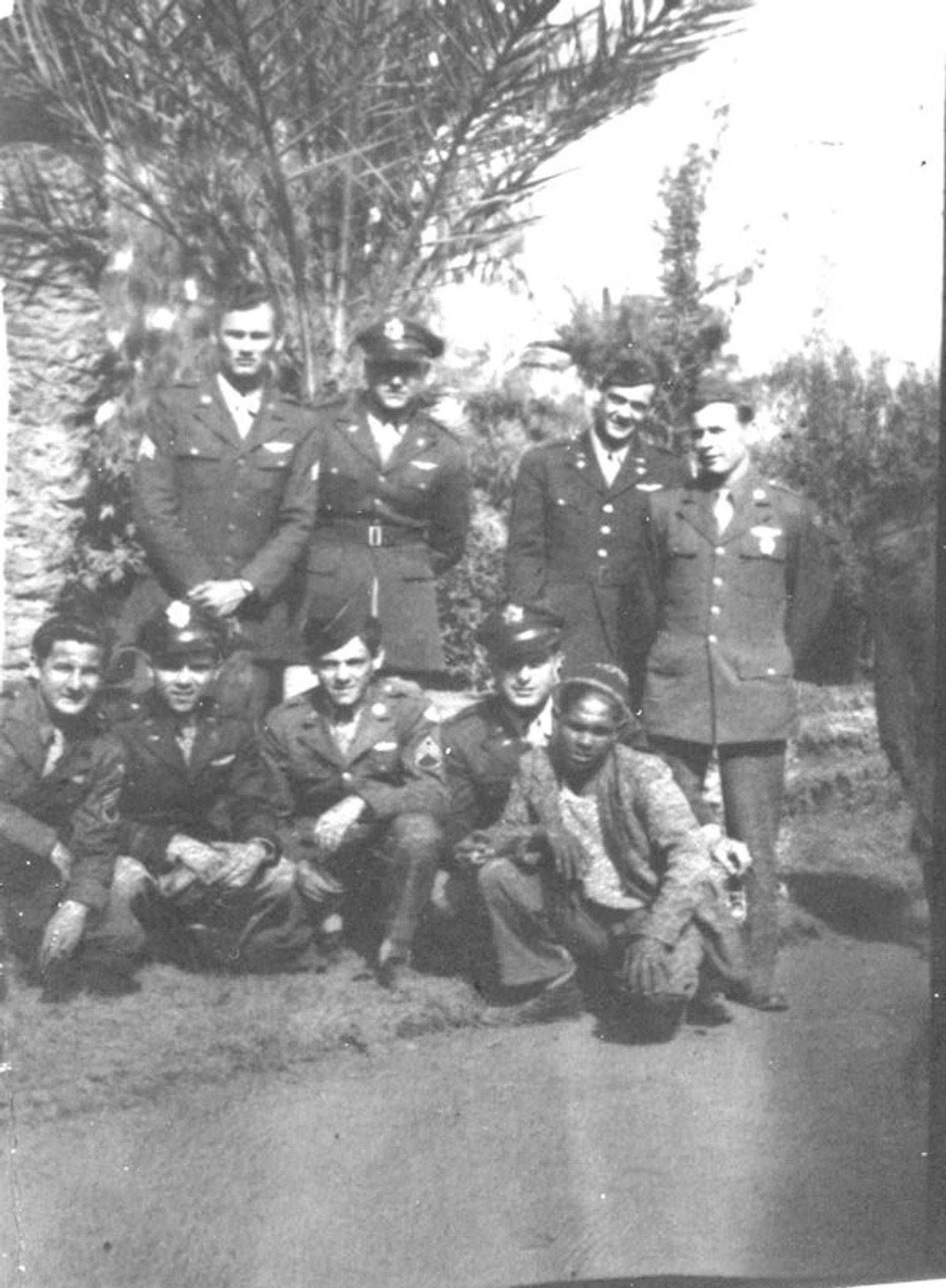
After I left there, I went to the mess hall where the crew was, and told them we were leaving in the morning for our home base. I also found out that the mess hall was about to close and they had started to re-arrange the tables and chairs because there was to be a USO show in the mess hall in less than an hour. Most of the crew members and I decided to stay for the show. The first acts were a singing group and a comedian who were very entertaining and then a singer, a baritone, by the name of Thomas L. Thomas. He was a great singer and sang songs like Old Man River, Swing Low Sweet Chariot, and Road to Mandalay. He was absolutely great and when he finished he was wildly applauded. But instead of reveling in the applause, he called all the other performers on stage to take a bow and then said “If we have made a favorable impression on you, we would like to leave you that way” and then he added “I will sing one more song” and he sang The Lord’s Prayer. It was the most beautiful rendition of that song that I have ever heard. When he finished, there was absolute silence and in about 5 seconds everyone applauded in a very earnest but subdued manner as to say “Thank you, thank you very much”. This was our introduction into the 8th Air Force and taught us that without fanfare we were there to do a job that someone needed to do and there was a God in the heavens who would be listening to our prayers.
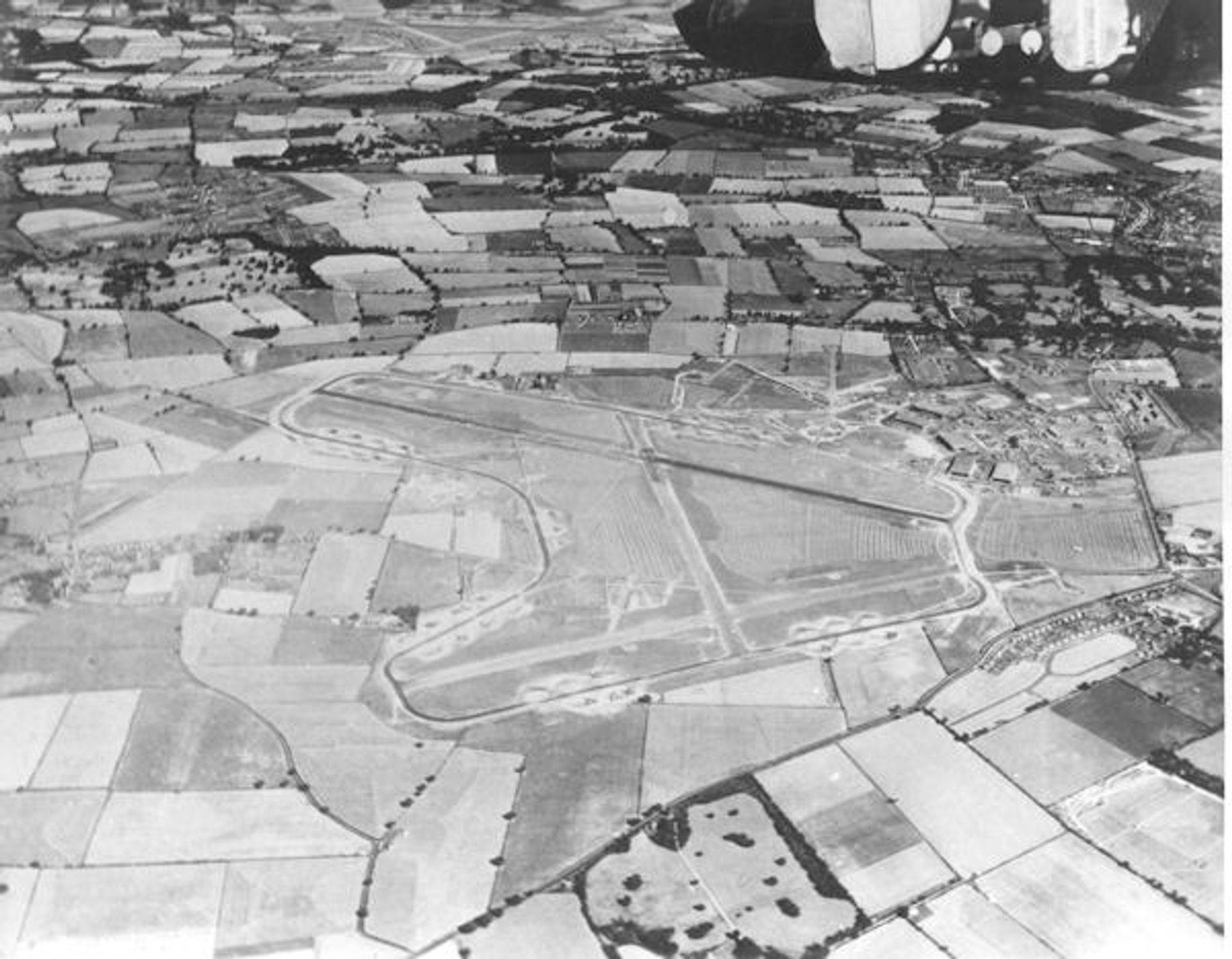
Horsham St Faith, AAF 123 as seen from the air
The next morning, Feb. 9, 1944, we went to our base at Horsham St. Faith, adjoining Norwich, England. This was a RAF (Royal Air Force) permanent base with many permanent brick buildings, as well as temporary army buildings, and this was the home base of the 458th Bombardment Group. We were fortunate to be on this base because many of the other bases were newly constructed with mostly temporary type buildings. Most of those bases reverted to farmland after the war but Horsham St. Faith is now the municipal airport for Norwich, a city [with a population] of over 150,000.
In 1983 Jean and I visited the base with Joe Brown and Louise and Bernie Doyle and Correy, and we were treated royally by a representative of the 2nd Air Division Museum at Norwich, and the manager of the Airport. They met us at the Norwich train station and took the six of us to the airport where they treated us to a typical English fancy luncheon, with wonderful drinks and food. We then toured the base in a large station wagon and found it very much the same as when we were there except that the temporary buildings had been removed. All the large hangers (at least 3) were still being used and the control tower looked the same, but we were informed it had been raised about 10 feet. We then drove out to where the B-24s had parked on various staggered concrete pads and then the base commander ordered the base closed for flying for 15 minutes, with no takeoffs or landings, and we went to the end of the runway where we had taken off many times for our training and 30 combat missions. This was a great thrill for all of us but of course more so for Joe, Bernie and me. As we drove down the runway, Bernie Doyle called out the airspeed as he always did on any takeoff. The B-24 empty (without bombs) could take off at 110-115 mph, but with a full bomb load of at least 6000 lbs. and a full load of fuel, we tried to get at least 130 mph at takeoff, only less if we ran out of runway. After this very exciting experience, they took us to the Air Force Museum mentioned above.
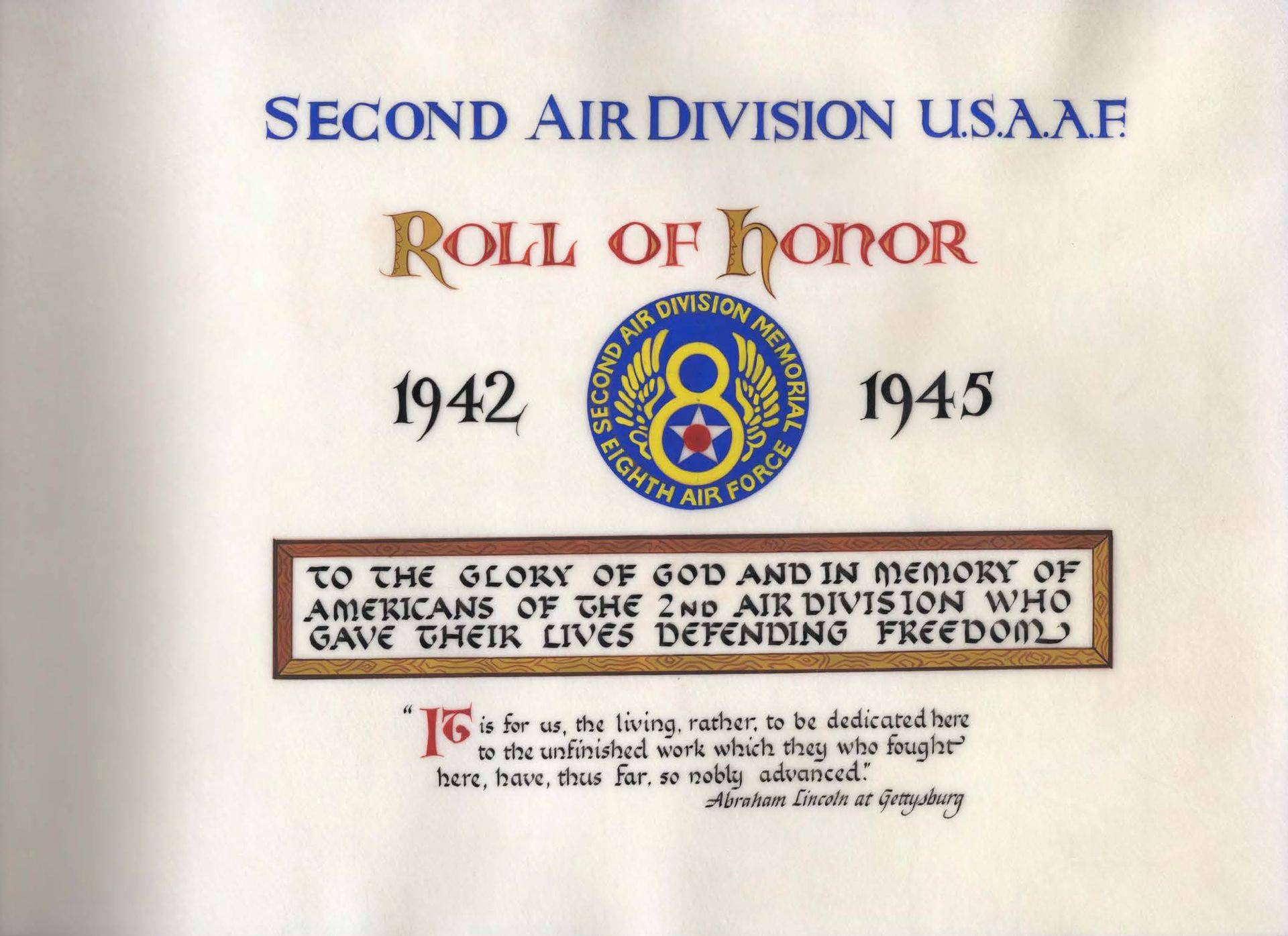
This memorial is in a wing of the Norwich Library and was started in May of 1945. 20,000 British pounds were pledged in less than one month by virtually everyone in the Second Air Division at the time, including Fighter as well as Bomber Groups. In making the presentation on May 25, 1945, to the Memorial Trust Fund, General Kepner said “This memorial must be a spiritually living thing. The deep and sacred feeling giving birth to this memorial –that our comrades’ spirits of youth, hope and desire for a world of decency, freedom and peace must live on –must be a haven wherein the bewildered stumbling footsteps of succeeding generations can be unerringly placed on the right paths”.
The 2nd Air Division, an association of 2nd Air Division veterans, has supported this memorial with gifts and within the last few years has added a trust fund of $500,000. The library has many books on the USA and is an excellent reference library for the British and others using the library. The fountain outside this museum has stones from every state in America. The Roll of Honor in the Memorial Room of the Central Library honors the memory of all men in the Second Air Division who sacrificed their lives in World War II. This Roll of Honor, we were told, contains over 6000 names, and is a large book which is opened and each day a page is turned, showing the names of the two open pages.
This experience of realizing that among those listed was S/Sgt. Chester Carlstrum and S/Sgt. Goldstein who were killed flying with other crews. Carlstrum was a full time crew member with Crew 74 and Goldstein, who took Murphy’s place on the crew, only flew about three missions with us. Although combat veterans will not admit to softness, nor loss of composure, I must admit that seeing those names gave all of us a feeling of sorrow and pain and again realizing that but for the grace of God our names could have been on that Roll of Honor book. I know that I and I know the others also, made a silent vow that we, the living, would always honor their memories and to the best of our abilities would rededicate our lives to do everything we could to assure they did not die in vain. After touring the library, our hosts took us back to the railroad station at Norwich and we went back to London 90 miles away to rejoin our European tour group. All of this lasted only about 6 hours, but provided all of us with a lifetime of memories.
